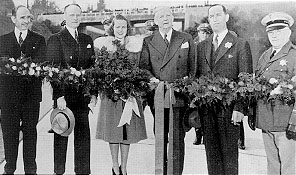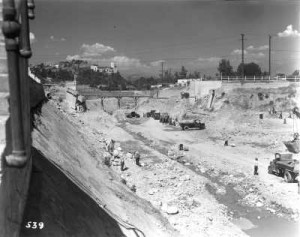“A Highway that Will Serve as a Model for the Future Development of Freeways in California”
On July 20, 1940, a 3.7-mile section of the Arroyo Seco Parkway opened to vehicle traffic.
It was not only California’s first “freeway” – a high-speed divided road with onramps and off-ramps – but also the first to be built in the urban Western United States and a prototype for future super highways.
The 8.2-mile roadway, finally completed in 1941, remains largely unchanged from its original configuration. Onramps and off-ramps are still exceedingly tight requiring swift acceleration from 5-miles-per-hour to 55-miles-per-hour or similarly quick braking.
A guardrail has replaced the plants that once graced the median, however.
Although engineered to accommodate 27,000 vehicles traveling at 45 miles-per-hour, volume now is closer to 122,000 each day. In part, that’s because despite its outmoded design, the roadway remains the fastest route between Pasadena and Los Angeles.
Renamed the Pasadena Freeway in November 1954 – State Route 110 – Caltrans restored its original name in 2010, replacing “Pasadena Freeway” with “Arroyo Seco Parkway” signs.
Planners had been exploring the possibility of a roadway along the dry riverbed from Pasadena to Los Angeles since the late 1890s.
The route was finally selected in 1936 and construction began in 1938.
Total cost: $5.75 million. Cheap – even by 1940 standards.
As originally designed, the parkway had two lanes in either direction, the inside passing lanes paved in black concrete and the outer ones in gray to help drivers stay in their lanes.
Shoulders on either side were ultimately abandoned to increase capacity.
 “It is proper and timely for us to pause a few moments to ceremonialize and celebrate an achievement so extraordinary as the completion of this, the Arroyo Seco Parkway,” said Gov. Culbert Olson in dedicating the completed freeway on December 30, 1940 – two days before the Tournament of Roses Parade and the Rose Bowl.
“It is proper and timely for us to pause a few moments to ceremonialize and celebrate an achievement so extraordinary as the completion of this, the Arroyo Seco Parkway,” said Gov. Culbert Olson in dedicating the completed freeway on December 30, 1940 – two days before the Tournament of Roses Parade and the Rose Bowl.
“Now that we have it, and it all looks so rather simple, so obviously necessary, so wholly practical, some will ask, ‘What is there so wonderful, or so bold about it?’ Oh yes–but it takes courage to do a thing the first time, no matter how simple and obvious it may appear after it is done. And this, fellow citizens, is the first freeway in the West. It is only the first. And that is its great promise to the future–the promise of many more freeways to come.”
In the program of the dedication ceremony at which Olson cut a chain of roses, the Democratic governor stressed the benefit of freeways to traffic safety:
“We must look ahead to an increase in traffic volume on our state highways of between 20 percent and 25 percent within the next 10 years. Traffic safety must be paramount in our minds.”
Upon completion – the leg through South Pasadena was finished January 30, 1941 — the highway became a new section of US Route 66.
The parkway is a State Scenic Highway, a National Scenic Byway and was listed in the National Register of Historic Places in 2011
*****
(Those shown in the photo of the official party at the ribbon cutting ceremony are, from left to right: Amerigo Bozzani, Highway Commissioner and chairman of the Celebration Committee; Director of Public Works Frank W. Clark; Sally Stanton, Queen of the 1941 Rose Festival; Olson; Larry Barrett, chairman, Highway Commission; and Chief Ray Cato of the California Highway Patrol.)
-30-
Filed under: California History
Capitol Cliches Conversational Currency Great Moments in Capitol History News Budget and Economy California History Demographics Fundraising Governor Legislature/Legislation Politics State Agencies
Opinionation Overheard Today's Latin Lesson
Restaurant Raconteur Spotlight Trip to Tokyo Venting Warren Buffett Welcome Words That Aren't Heard in Committee Enough


“ceremonialize”? Even back then.
Comment by JoAnn Anglin — 7.20.2012 @ 10:04 pm